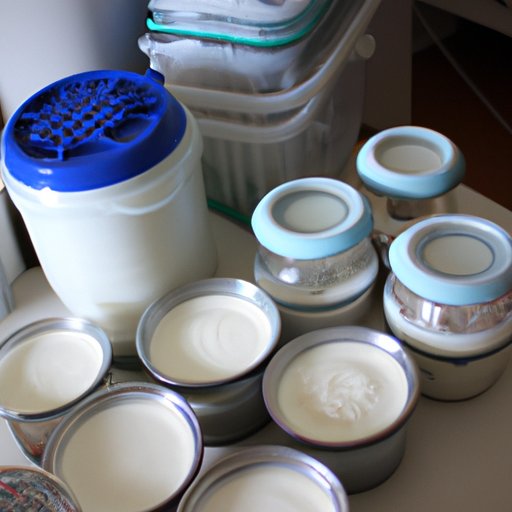Introduction
Making yogurt at home can be a rewarding and cost-effective experience. With the right ingredients and supplies, it is possible to make delicious yogurt without having to buy it in stores. This article provides a comprehensive guide on how to make yogurt at home, from gathering the necessary ingredients and supplies to properly cooling and storing the yogurt.
Gather the Ingredients and Supplies Needed to Make Yogurt at Home
The first step to making yogurt at home is gathering all of the necessary ingredients and supplies. The list of required ingredients includes milk, starter culture, and sugar or other sweetener (optional). For the milk, any type of dairy milk or non-dairy milk can be used. As for the starter culture, plain yogurt with live cultures is the best option. In terms of supplies, a pot, a thermometer, a spoon, and a container for incubating the yogurt are all needed.
Choose a Milk Option for Making Yogurt
Once the ingredients and supplies have been gathered, the next step is choosing a milk option for making yogurt. There are several types of milk that are suitable for making yogurt, including cow’s milk, goat’s milk, and non-dairy milks such as almond milk, coconut milk, and soy milk. When selecting a milk option, it is important to consider the fat content of the milk, as this will affect the texture and thickness of the finished yogurt.

Heat the Milk Until It Reaches the Desired Temperature
The next step in making yogurt at home is heating the milk until it reaches the desired temperature. The ideal temperature for making yogurt is between 180 degrees Fahrenheit and 185 degrees Fahrenheit. It is important to heat the milk slowly and gradually, stirring constantly to prevent burning or scorching. There are several methods for heating the milk, including using a pot on the stovetop, a double boiler, or a microwave.
Add the Starter Culture to the Milk
Once the milk has reached the desired temperature, the next step is adding the starter culture to the milk. Different types of starter cultures can be used, including plain yogurt with live cultures, freeze-dried yogurt starter, or yogurt cultures purchased from a specialty store. It is important to ensure that the starter culture is fully dissolved in the milk before proceeding to the next step.

Incubate the Yogurt in a Warm Place
The next step in making yogurt at home is incubating the mixture in a warm place. To create the right environment for incubation, it is important to keep the yogurt mixture at a consistent temperature of between 100 degrees Fahrenheit and 110 degrees Fahrenheit. It is also important to avoid drafts and direct sunlight during the incubation process. Tips for ensuring a successful incubation process include wrapping the container with a towel or blanket and placing it in an oven with the light turned on.

Cool and Store the Yogurt Properly
Once the yogurt has finished incubating, the next step is cooling and storing the yogurt properly. To cool the yogurt, it can be placed in the refrigerator for several hours or in the freezer for a few minutes. Once cooled, the yogurt should be stored in an airtight container in the refrigerator for up to one week. It is important to note that homemade yogurt will not last as long as store-bought yogurt due to the absence of preservatives.
Conclusion
Making yogurt at home is a great way to save money and enjoy a delicious treat. This article provided a comprehensive guide on the steps involved in making yogurt at home, from gathering the necessary ingredients and supplies to properly cooling and storing the yogurt. With the right ingredients and supplies, it is possible to make delicious yogurt without having to buy it in stores.


